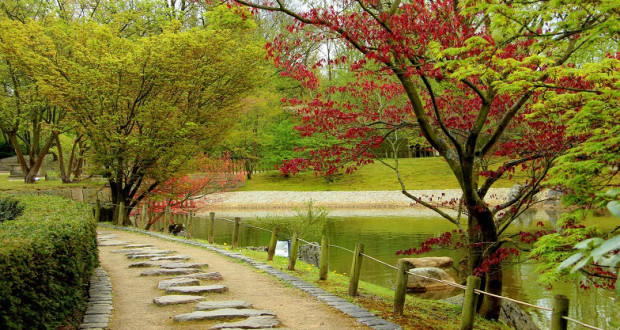Japanese landscape design makes a statement not only about the surroundings, but the culture itself. You may find similarities between Chinese, Japanese, and Korean landscape designs while strolling through an Asian-inspired garden, because pieces of these cultures originated from similar ideas. Japanese design, in particular, reveals its culture within the design in a noticeable way. The elements in a Japanese garden are placed carefully and purposefully to represent the culture. With the carefully chosen placement of objects and the selection of plants in a Japanese garden, there is no denying that their garden represents more than just the plants within them.
Flowers
“When choosing a flower for a garden, it’s not likely that you will see white flowers in a Japanese style garden,” said Dean Bjorkstrand, owner of a landscaping service. “This is because white flowers are seen to be a funeral flower in the Japanese culture. This goes the same for any color of chrysanthemum, as they too have a similar meaning. The landscape design is going to steer clear of sorrow, and focus more on relaxation and peace throughout the garden.”
Green Plants
Using various green plants creates a landscape that looks fresh and full of life. Asian gardens usually feature a nice array of textured plants. There may be the fluffy Japanese bush, soft and colorful limbs of the Japanese Bottlebrush, as well as the stiffness of a bonsai tree, all in the same frame. This makes the garden enjoyable and interesting to look at.
Besides the different textures, a Japanese Garden also uses a nice range of height in the plants throughout the landscape design. Tall bamboo shoots can tower over most the plants if you let them. The use of various types of pine trees and deciduous trees—such as the Himalayan white pine or a willow—can also be seen in Japanese gardens.
Incorporating these types of plants will give an Asian atmosphere in your landscaping, but what will really make it true to Japanese design is using these plants to create a focal point in the yard. This can be accomplished by placing a tree in a location that can be viewed throughout the yard. Then place around it very low-lying plants, like moss or low ground covering plants. This will surely make the tree stand out and draw attention to it. A dramatic focal point relates to the Japanese culture by taking an under-utilized area and making it the center of attention. Using a “less is more” concept by not filling the whole garden with plants and busyness really captures the Japanese influence, as well as having that one central piece that really grabs your attention.
Garden Path
“Often times in Japanese gardens you will see some kind of path. Many paths will be with natural stones and rocks,” said Chris Ochs, spokesperson for a landscaping company in St. Paul, MN. Creating walkways will add character to the landscape design. Japanese paths tend to have some kind of a curve to them, and are rarely straight. This originates from the belief that evil spirits may follow the path into the home. So a curvy path will hopefully mislead the evil spirit away from the home, because it may be more difficult to follow than a straight path.
These are just a few of the elements in Japanese landscape design that reveal the culture. These gardens are pure art, and each part is carefully planned to represent some belief symbolically. Next time you stroll through an Asian inspired garden, see if you can pick up on the symbolism and the deeper meanings of the culture behind the design.
 Living There
Living There


